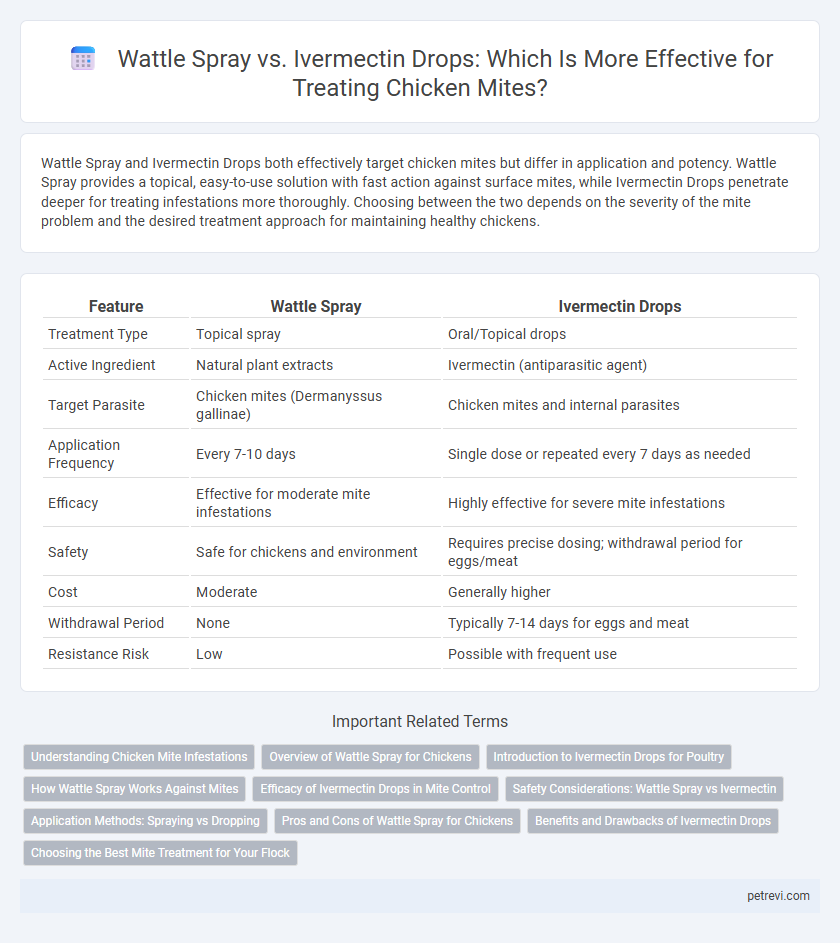Wattle Spray and Ivermectin Drops both effectively target chicken mites but differ in application and potency. Wattle Spray provides a topical, easy-to-use solution with fast action against surface mites, while Ivermectin Drops penetrate deeper for treating infestations more thoroughly. Choosing between the two depends on the severity of the mite problem and the desired treatment approach for maintaining healthy chickens.
Table of Comparison
| Feature | Wattle Spray | Ivermectin Drops |
|---|---|---|
| Treatment Type | Topical spray | Oral/Topical drops |
| Active Ingredient | Natural plant extracts | Ivermectin (antiparasitic agent) |
| Target Parasite | Chicken mites (Dermanyssus gallinae) | Chicken mites and internal parasites |
| Application Frequency | Every 7-10 days | Single dose or repeated every 7 days as needed |
| Efficacy | Effective for moderate mite infestations | Highly effective for severe mite infestations |
| Safety | Safe for chickens and environment | Requires precise dosing; withdrawal period for eggs/meat |
| Cost | Moderate | Generally higher |
| Withdrawal Period | None | Typically 7-14 days for eggs and meat |
| Resistance Risk | Low | Possible with frequent use |
Understanding Chicken Mite Infestations
Chicken mite infestations cause irritation, reduced egg production, and anemia in poultry, making effective treatment crucial. Wattle Spray delivers direct contact insecticidal action on hard-to-reach areas like wattles, effectively eliminating mites without chemical residues. Ivermectin Drops provide systemic parasite control by targeting mites internally through oral or injectable administration, offering comprehensive infestation management in chicken flocks.
Overview of Wattle Spray for Chickens
Wattle Spray is a topical solution designed to target chicken mites by creating a protective barrier on the bird's skin, effectively reducing mite infestations. It contains natural insecticidal ingredients that are safe for chickens and help minimize irritation and itching associated with mite bites. Regular application of Wattle Spray supports overall poultry health by controlling external parasites without the chemical residues often found in systemic treatments like ivermectin drops.
Introduction to Ivermectin Drops for Poultry
Ivermectin drops serve as a highly effective poultry treatment targeting chicken mites by directly eliminating these parasites through systemic absorption. This antiparasitic solution offers a convenient, precise application method, ensuring improved chicken health and reduced mite infestations compared to traditional wattle sprays. The potency of ivermectin drops combined with its ease of use makes it a preferred choice for sustainable mite management in poultry farming.
How Wattle Spray Works Against Mites
Wattle Spray targets chicken mites by creating a protective barrier on the bird's skin and feathers, which suffocates and repels the parasites upon contact. Its active ingredients often include natural oils and insecticides that disrupt mite nervous systems, leading to rapid mite elimination. This method minimizes stress on chickens and reduces the risk of chemical resistance compared to systemic treatments like Ivermectin Drops.
Efficacy of Ivermectin Drops in Mite Control
Ivermectin drops demonstrate superior efficacy in controlling chicken mites by targeting multiple mite life stages, resulting in rapid infestation reduction. The systemic action of ivermectin ensures prolonged protection compared to surface-only treatments like wattle spray. Studies indicate ivermectin's high bioavailability and long residual effect contribute to effective and sustained mite eradication in poultry flocks.
Safety Considerations: Wattle Spray vs Ivermectin
Wattle Spray for chicken mite treatment offers a natural and less toxic alternative, reducing risks of chemical residues and adverse reactions in poultry. Ivermectin drops, while effective, require precise dosing to avoid toxicity and potential resistance development in mites. Choosing between Wattle Spray and Ivermectin involves weighing safety profiles, with Wattle Spray favored for organic flocks and Ivermectin used under veterinary guidance.
Application Methods: Spraying vs Dropping
Chicken mite treatment methods differ significantly between wattle spray and ivermectin drops, with application techniques impacting effectiveness and ease. Wattle spray is applied directly onto the chicken's body and feathers, ensuring broad coverage over skin surfaces where mites commonly hide. Ivermectin drops require precise administration to the bird's skin or oral cavity, offering targeted mite elimination but demanding careful dosing for best results.
Pros and Cons of Wattle Spray for Chickens
Wattle Spray offers a targeted approach to chicken mite treatment by directly coating the affected areas, ensuring quick relief and reducing the risk of mite resistance compared to Ivermectin Drops. Its natural formulation often results in fewer side effects, making it safer for regular use and minimizing chemical residues in poultry products. However, Wattle Spray may require more frequent application and can be less effective against severe infestations, necessitating careful monitoring and possible combination with other treatments.
Benefits and Drawbacks of Ivermectin Drops
Ivermectin drops provide a targeted and effective treatment for chicken mites by paralyzing and killing parasites rapidly, reducing mite infestation and improving poultry health. Their benefits include ease of application, systemic action reaching mites in hidden areas, and prolonged residual effect compared to topical sprays. However, drawbacks involve potential resistance development, toxicity risks if overdosed, withdrawal periods before egg consumption, and the need for precise dosing to avoid harming birds.
Choosing the Best Mite Treatment for Your Flock
Wattle spray and ivermectin drops offer effective chicken mite treatment with different modes of action tailored to flock needs. Wattle spray provides a quick, external solution by suffocating adult mites and eggs on the bird's skin, while ivermectin drops deliver systemic control, targeting mites internally through the bloodstream. Choosing the best mite treatment depends on factors such as the severity of infestation, ease of application, safety for chickens, and withdrawal times before egg consumption.
Wattle Spray vs Ivermectin Drops for Chicken Mite Treatment Infographic

 petrevi.com
petrevi.com